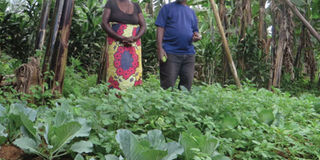When abundance of food does not reduce malnutrition

A local farmer shows off some of the vegetables grown in her homestead. Vegetables are an important part of the diet. Courtesy photo
From a relatively dry Kampala to an evergreen western Uganda, the journey to Mbarara, Kabale and Kisoro during the rains of early June was slippery yet satisfying.
Travelling through the hills of Mbarara where matooke grows in abundance to those of Kisoro where irish potatoes are grown in many homesteads, one wonders why there are stories of malnutrition.
People in these areas should not, under normal circumstances, be suffering from malnutrition.
Causes of malnutrition
According to Moses Mutabazi, the Kisoro District nutrition specialist, one of the causes of malnutrition in south western Uganda is selling off all the foodstuffs grown by families.
“Since we do not have cash crops, households sell the food crops. You can find a family harvesting up to 40 bags of Irish potatoes but selling them off and remaining with nothing. When this happens, they end up without food to eat,” Mutabazi explains.
Globally, malnutrition is mainly caused by the lack of access to highly nutritious foods in addition to high food prices which limit access to food.
However, none of these apply to western Uganda. Unlike some dry regions where food can hardly be grown, the west has fertile soils and favourable climate to allow for the growing of various foods.
Emily Tindimweba, the nursing officer in-charge of the paediatric ward at Kabale hospital cites ignorance as one of the causes of malnutrition in the region.
In addition, Hope Hamibana, Kisoro District nutrition focal person and the principal education officer, says many people do not understand a balanced diet.
“People think that eating meat, drinking milk and doing away with vegetables is having a balanced diet. Many people do not know that the foods regularly eaten at home can be prepared well to make a balanced diet,” Habimana explains.
Poor family planning and gender-based violence were also cited as major causes of malnutrition.
Implications of malnutrition on health
According to the 2011-2016 Nutrition Action Plan, the deficiencies most associated with malnutrition include Vitamin A deficiency, which affects one out of five young children and women of reproductive age.
It results into impaired resistance to infection and, consequently, higher levels of illness and mortality, as well as potentially severe eye problems.
“Iron-deficiency anaemia affects three-quarters of children under five years and half of women of reproductive age.
In children, anaemia leads to a significant slowdown in cognitive development, decreased physical activity, and reduced resistance to disease,” the plan reads in part.
There also arises zinc deficiency, which ranges from 20 per cent to 70 per cent in young children and 20 per cent to 30 per cent in adults. It results in poor growth, reduced resistance to infectious diseases, and increased incidence of stillbirths.
According to the Kisoro District nutrition specialist, HIV and malnutrition affect each other.
“Malnutrition leads to a higher progress of HIV. When a person has HIV, they are most likely to have mouth sores which can affect the appetite and general nutrition of the patient.”
What has been done?
Under a Usaid-funded five-year project, government plans to promote healthy nutrition practices and improve awareness on malnutrition were realised.
The 2011-2016 Usaid Strengthening Partnerships, Results and Innovations in Nutrition Globally project (SPRING) was implemented by JSI Research & Training Institute Inc., Helen Keller International (HKI) and Save the Children, among others, aimed at preventing stunting and maternal and child anaemia in the first 1000 days of the child’s life.
Tindimweba, says the project has helped to reduce malnutrition in the region since its implementation two years ago.
“We used to get severe cases of malnutrition with many children underweight, stunted or having low birth weight. We used to admit up to 15 people with severe malnutrition before but all this has changed and we admit a maximum of five people,” Tindimweba explains.
Through the establishment of kitchen demonstration gardens, area residents have been taught the relevance of vegetables in the diet and how to prepare nutritious meals with what is available in their homes.
According to Solomon Basaza, Kisoro District agricultural officer, 4,200 such gardens have been set up in the district. He identifies animal proteins as lacking in the meals of most locals, who cater mostly for plant nutrients.
A 2013 World Food Programme report on malnutrition, Cost of Hunger in Uganda, showed that 44 per cent of the health costs associated with under nutrition occur before the child turns one year old.
The annual costs associated with under nutrition of children were estimated at Shs1.8 trillion. This is equivalent to 5.6 per cent of the country’s GDP. Given that many areas of Uganda produce an abundance of food, this is a heavy and unnecessary cost to bear.
The numbers
44%: Children wasted or stunted in western uganda (opm 2013)
5.6%: Percentage of gdp spent annually to address malnutrition
54%: Adults who suffered stunting as children (WFP 2013)




